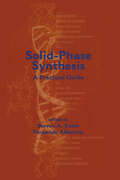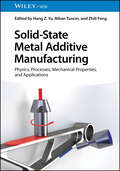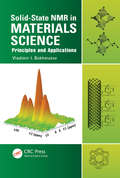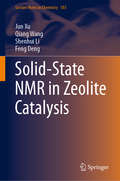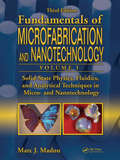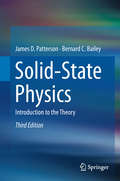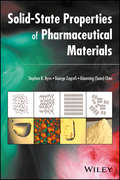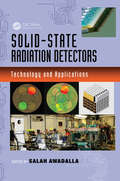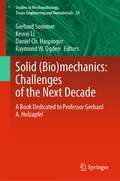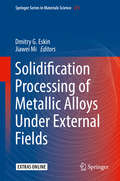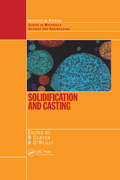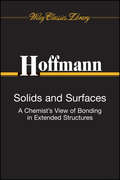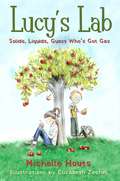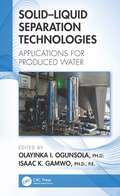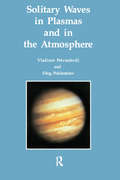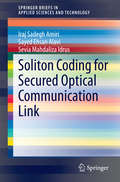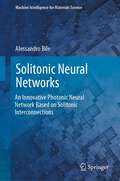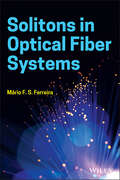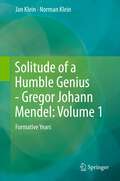- Table View
- List View
Solid-Phase Synthesis: A Practical Guide
by Steven A. Kates Fernando AlbericioThis volume provides the information needed to synthesize peptides by solid-phase synthesis (SPS) - employing polymeric support (resins), anchoring linkages (handles), coupling reagents (activators), and protection schemes. It presents strategies for creating a wide variety of compounds for drug discovery and analyzes peptides, DNA, carbohydrates,
Solid-State Metal Additive Manufacturing: Physics, Processes, Mechanical Properties, and Applications
by Zhili Feng Hang Z. Yu Nihan TuncerSolid-State Metal Additive Manufacturing Timely summary of state-of-the-art solid-state metal 3D printing technologies, focusing on fundamental processing science and industrial applications Solid-State Metal Additive Manufacturing: Physics, Processes, Mechanical Properties, and Applications provides detailed and in-depth discussion on different solid-state metal additive manufacturing processes and applications, presenting associated methods, mechanisms and models, and unique benefits, as well as a detailed comparison to traditional fusion-based metal additive manufacturing. The text begins with a high-level overview of solid-state metal additive manufacturing with an emphasis on its position within the metal additive manufacturing spectrum and its potential for meeting specific demands in the aerospace, automotive, and defense industries. Next, each of the four categories of solid-state additive technologies—cold spray additive manufacturing, additive friction stir deposition, ultrasonic additive manufacturing, and sintering-based processes—is discussed in depth, reviewing advances in processing science, metallurgical science, and innovative applications. Finally, the future directions of these solid-state processes, especially the material innovation and artificial intelligence aspects, are discussed. Sample topics covered in Solid-State Metal Additive Manufacturing include: Physical processes and bonding mechanisms in impact-induced bonding and microstructures and microstructural evolution in cold sprayed materialsProcess fundamentals, dynamic microstructure evolution, and potential industrial applications of additive friction stir depositionMicrostructural and mechanical characterization and industrial applications of ultrasonic additive manufacturingPrinciples of solid-state sintering, binder jetting-based metal printing, and sintering-based metal additive manufacturing methods for magnetic materialsCritical issues inherent to melting and solidification, such as porosity, high residual stress, cast microstructure, anisotropic mechanical properties, and hot cracking Solid-State Metal Additive Manufacturing is an essential reference on the subject for academic researchers in materials science, mechanical, and biomedicine, as well as professional engineers in various manufacturing industries, especially those involved in building new additive technologies.
Solid-State NMR in Materials Science: Principles and Applications
by Vladimir I. BakhmutovSolid-state NMR is a powerful physical method widely applied in modern fundamental and applied science, medicine, and industry. Its role is particularly valuable in materials chemistry due to the capability of solid-state NMR to rapidly solve tasks connected with structural descriptions of complex systems on macro and/or molecular levels, and the i
Solid-State NMR in Zeolite Catalysis (Lecture Notes in Chemistry #103)
by Jun Xu Qiang Wang Shenhui Li Feng DengSolid-State NMR Characterization of Heterogeneous Catalysts and Catalytic Reactions provides a comprehensive account of state-of-the-art solid-state NMR techniques and the application of these techniques in heterogeneous catalysts and related catalytic reactions. It includes an introduction to the basic theory of solid-state NMR and various frequently used techniques. Special emphasis is placed on characterizing the framework and pore structure, active site, guest-host interaction, and synthesis mechanisms of heterogeneous catalysts using multinuclear one- and two-dimensional solid-sate NMR spectroscopy. Additionally, various in-situ solid-state NMR techniques and their applications in investigation of the mechanism of industrially important catalytic reactions are also discussed. Both the fundamentals and the latest research results are covered, making the book suitable as a reference guide for both experienced researchers in and newcomers to this field.Feng Deng is a Professor at Wuhan Institute of Physics and Mathematics, Chinese Academy of Sciences.
Solid-State Physics for Electronics
by Andre MolitonDescribing the fundamental physical properties of materials used in electronics, the thorough coverage of this book will facilitate an understanding of the technological processes used in the fabrication of electronic and photonic devices. The book opens with an introduction to the basic applied physics of simple electronic states and energy levels. Silicon and copper, the building blocks for many electronic devices, are used as examples. Next, more advanced theories are developed to better account for the electronic and optical behavior of ordered materials, such as diamond, and disordered materials, such as amorphous silicon. Finally, the principal quasi-particles (phonons, polarons, excitons, plasmons, and polaritons) that are fundamental to explaining phenomena such as component aging (phonons) and optical performance in terms of yield (excitons) or communication speed (polarons) are discussed.
Solid-State Physics, Fluidics, and Analytical Techniques in Micro- and Nanotechnology
by Marc J. MadouProviding a clear theoretical understanding of MEMS and NEMS, Solid-State Physics, Fluidics, and Analytical Techniques in Micro- and Nanotechnology focuses on nanotechnology and the science behind it, including solid-state physics. It provides a clear understanding of the electronic, mechanical, and optical properties of solids relied on in integra
Solid-State Physics: Introduction To The Theory
by James D. Patterson Bernard C. BaileyThis book teaches solid state physics in a comprehensive way, covering all areas. It begins with three broad topics: how and why atoms bind together to form solids, lattice vibrations and phonons, and electrons in solids. It then applies this knowledge to interactions, especially those between electrons and phonons, metals, the Fermi surface and alloys, semiconductors, magnetism, superconductivity, dielectrics and ferroelectrics, optical properties, defects, layered materials, quantum Hall effect, mesoscopics, nanophysics and soft condensed matter. Further important topics of the book are the evolution of BEC to BCS phenomena, conducting polymers, graphene, iron pnictide superconductors, light emitting diodes, N-V centers, nanomagnetism, negative index of refraction, optical lattices, phase transitions, phononics, photonics, plasmonics, quantum computing, solar cells, spin Hall effect and spintronics. <P><P> In this 3rd edition, topics such as topological insulators, quantum computing, Bose–Einstein transitions, highly correlated electron systems and several others have been added. New material on magnetism in solids, as well as a discussion of semiconductors and a changed set of problems with solutions, are also included. The book also discusses “folk theorems” to remind readers of the essence of the physics without mathematics, and includes 90 mini-biographies of prominent solid state physicists of the past and present to put a human face on the subject. An extensive solutions manual rounds out the book.
Solid-State Properties of Pharmaceutical Materials
by Stephen R. Byrn George Zografi Xiaoming Sean ChenPresents a detailed discussion of important solid-state properties, methods, and applications of solid-state analysis Illustrates the various phases or forms that solids can assume and discussesvarious issues related to the relative stability of solid forms and tendencies to undergo transformation Covers key methods of solid state analysis including X-ray powder diffraction, thermal analysis, microscopy, spectroscopy, and solid state NMR Reviews critical physical attributes of pharmaceutical materials, mainly related to drug substances, including particle size/surface area, hygroscopicity, mechanical properties, solubility, and physical and chemical stability Showcases the application of solid state material science in rational selection of drug solid forms, analysis of various solid forms within drug substance and the drug product, and pharmaceutical product development Introduces appropriate manufacturing and control procedures using Quality by Design, and other strategies that lead to safe and effective products with a minimum of resources and time
Solid-State Radiation Detectors: Technology and Applications (Devices, Circuits, and Systems #41)
by SALAH AWADALLA AND KRZYSZTOF INIEWSKIIntegrating aspects of engineering, application physics, and medical science, Solid-State Radiation Detectors: Technology and Applications offers a comprehensive review of new and emerging solid-state materials-based technologies for radiation detection. Each chapter is structured to address the current advantages and challenges of each material and technology presented, as well as to discuss novel research and applications. Featuring contributions from leading experts in industry and academia, this authoritative text:Covers modern semiconductors used for radiation monitoringExamines CdZnTe and CdTe technology for imaging applications including three-dimensional capability detectorsHighlights interconnect technology for current pixel detectorsDescribes hybrid pixel detectors and their characterizationsTackles the integrated analog signal processing read-out front ends for particle detectorsConsiders new organic materials with direct bandgap for direct energy detectionSummarizes recent developments involving lanthanum halide and cerium bromide scintillatorsAnalyzes the potential of recent progress in the field of crystallogenesis, quantum dots, and photonics crystals toward a new concept of x- and gamma-ray detectors based on metamaterialsExplores position-sensitivity photomultipliers and silicon photomultipliers for scintillation crystalsSolid-State Radiation Detectors: Technology and Applications provides a valuable reference for engineers and scientists looking to enhance the performance of radiation detector technology for medical imaging and other applications.
Solid: A Book Dedicated to Professor Gerhard A. Holzapfel (Studies in Mechanobiology, Tissue Engineering and Biomaterials #24)
by Raymond W. Ogden Gerhard Sommer Kewei Li Daniel Ch. HaspingerThis book offers a comprehensive and timely overview of the latest developments in the field of biomechanics and extensive knowledge of tissue structure, function, and modeling. Gathering chapters written by authoritative scientists, it reports on a range of continuum and computational models of solids, and related experimental works, for biomechanical applications. It discusses cutting-edge advances such as constitutive modeling and computational simulation of biological tissues and organs under physiological and pathological conditions, and their mechanical characterization. It covers innovative studies on arteries, heart, valvular tissue, and thrombus, brain tumor, muscle, liver, kidney, and stomach, among others. Written in honor of Professor Gerhard A. Holzapfel, the book provides specialized readers with a thorough and timely overview of different types of modeling in biomechanics, and current knowledge about biological structures and function.
Solidification Processing of Metallic Alloys Under External Fields (Springer Series in Materials Science #273)
by Dmitry G. Eskin Jiawei MiThis book explores the application of external physical fields to the solidification processing of metallic alloys. Leading academics from around the world present comprehensive and critical reviews on state-of-the-art research and discuss possible future directions. Major physical fields, including electromagnetic, electric, acoustic, and thermal, are considered. In addition, the most advanced synchrotron X-ray based real-time and in-situ studies and numerical modeling methodologies are reviewed and discussed, with a special emphasis on their applications to the solidification processes. Throughout, all chapters are illustrated with both historical and very recent research cases, including typical examples of in-situ studies, modeling, and simulation. This book contains essential knowledge and information suitable for a wide audience, from undergraduate and postgraduate students to academics, practicing researchers, and engineers in materials, metallurgy, and manufacturing.
Solidification and Casting:
by Brian Cantor K O'ReillyWritten by leading experts in their respective fields, Solidification and Casting provides a comprehensive review of topics fundamental to metallurgy and materials science as well as indicates recent trends.From an industrial perspective, the book begins with chapters on the casting techniques most commonly used in industry today. It then d
Solids and Liquids
by Lawrence Hall of Science University of California at Berkeley Delta EducationNIMAC-sourced textbook
Solids and Liquids
by Lawrence Hall of ScienceIntegrate reading and language arts in the context of science with original student books developed specifically to complement FOSS modules. Students extend and reinforce their classroom discoveries and vocabulary after their hands-on explorations of life, earth, and physical science concepts. Large, colorful photographs and appropriate text enhance the science learning experience.
Solids and Liquids
by The Editors at the University of California at BerkeleyExplores the properties of solids and liquids. Simple wording and everyday examples are used to help children better understand the differences.
Solids and Surfaces: A Chemist's View of Bonding in Extended Structures (Professional Reference Ser.)
by Roald HoffmannThis unique book shows how chemistry and physics come together in the solid state and on surfaces. Using a lively, graphic, descriptive approach, it teaches chemists the language that is necessary to understand the electronic structure of extended systems. And, at the same time, it demonstrates how a chemical, frontier-orbital, approach to solid state and surface bonding and reactivity may be constructed. The book begins with the language of crystal orbitals, band structures and densities of states. The tools for moving back from the highly delocalized orbitals of the solid are then built up in a transparent manner; they include decompositions of the densities of states and crystal orbital overlap populations. Using these tools, the book shapes a meeting ground between detailed quantum mechanical calculations and a chemical frontier orbital perspec- tive. Applications include a general picture of chemisorption, bond-breaking and making in the solid state, bonding in metals, the electronic structure of selected conducting and supercon- ducting structures, dissociation, migration and coupling on surfaces and the forces controlling deformation of extended systems.
Solids, Liquids And Gases
by John M. PattenAn educational look at solids, liquids, and gasses for kids.
Solids, Liquids, Guess Who's Got Gas?: Lucy's Lab #2 (Lucy?s Lab)
by Michelle Houts Elizabeth ZechelAutumn has arrived, and at Granite City Elementary School everyone is gearing up for the biggest and best event of the year: the Harvest Festival. The whole school is excited about the games, the contests, the food, and, most of all, the costumes! Everyone except Lucy. She doesn’t like dressing up, and has no desire to be a fairy princess or rock star, even for one day. But Lucy is excited about the new science unit Miss Flippo has started: the states of matter. Lucy and her friends understand solids and liquids. They’re easy. But gasses are more difficult to grasp. When the class goes on a field trip to an orchard and Stewart Swinefest eats too many apples, and gets a serious stomachache, Lucy suddenly understands that even if you can’t see gasses they can fill space and expand, and even make you move. And with Stewart feeling better, she has a really great idea for her Harvest Festival costume, too.The second book in a new chapter book series from IRA Children’s Book Award-winner, Michelle Houts, Solids, Liquids, Guess Who’s Got Gas draws on STEM themes and is aligned with curriculum guidelines to bring a love of science to young readers, inspiring them to start their own labs and explore their world.
Solid–Liquid Separation Technologies: Applications for Produced Water
by Olayinka I. OgunsolaThis book presents recent research and advances in various solid–liquid separation technologies and some applications for treating produced water. It covers fundamental principles and the importance of produced water in major industrial sectors and compares solid–liquid separation technologies. In addition, this book Presents the results of research studies conducted to evaluate the performance of solid–liquid separation technologies Discusses a wide range of technologies, including membrane, filtration, crystallization, desalination, supercritical fluids, coagulation, and floatation Includes experimental, theoretical, modeling, and process design studies With its comprehensive coverage, this book is an essential reference for chemical researchers, scientists, and engineers in industry, academia, and professional laboratories. It is also an important resource for graduate and advanced undergraduate students studying solid–liquid separations.
Solitary Waves Plasms Atmosph
by V.I. Petviashvili O.A. Pohkotelov O.A. PokhotelovFirst Published in 1992. Routledge is an imprint of Taylor & Francis, an informa company.
Soliton Coding for Secured Optical Communication Link
by Iraj Sadegh Amiri Sayed Ehsan Alavi Sevia Mahdaliza IdrusNonlinear behavior of light such as chaos can be observed during propagation of a laser beam inside the microring resonator (MRR) systems. This Brief highlights the design of a system of MRRs to generate a series of logic codes. An optical soliton is used to generate an entangled photon. The ultra-short soliton pulses provide the required communication signals to generate a pair of polarization entangled photons required for quantum keys. In the frequency domain, MRRs can be used to generate optical millimetre-wave solitons with a broadband frequency of 0-100 GHz. The soliton signals are multiplexed and modulated with the logic codes to transmit the data via a network system. The soliton carriers play critical roles to transmit the data via an optical communication link and provide many applications in secured optical communications. Therefore, transmission of data information can be performed via a communication network using soliton pulse carriers. A system known as optical multiplexer can be used to increase the channel capacity and security of the signals.
Solitonic Neural Networks: An Innovative Photonic Neural Network Based on Solitonic Interconnections (Machine Intelligence for Materials Science)
by Alessandro BileThis book delves into optics and photonic materials, describing the development of an intelligent all-optical system capable of replicating the functional building blocks of the biological brain. Starting with an analysis of biological neuronal dynamics and traversing the state of the art of neuromorphic systems developed to date, the book arrives at a description of neural networks realized through spatial soliton technology.After a brief introduction to the biology of neural networks (Chapter 1), the book delves into the description of the neuromorphic problem emphasizing the peculiarities of optical hardware developed to date. (Chapter 2). Chapter 3 is dedicated to the description of psychomemories , which represent the modeling of human learning according to the theories of modern neuro-psychology. This chapter provides the prerequisites for understanding how solitonic neural networks (SNNs) are able to learn and how they approach biological models. Chapter 4 focuses on the experimentation of solitonic optic neurons in thin layers of lithium niobate. Optical techniques for supervised and unsupervised learning are discussed. The entire chapter is accompanied by theoretical, simulative and experimental results. This chapter explains how an X-junction neuron is able to establish synapses, modify them, or erase them. The erasure of solitonic structures represents an important innovation in the field of nonlinear optics. Finally, Chapter 5 reports on the implementation of a network of neurons capable of processing information and storing it exactly as a human episodic memory does. The chapter ends with a number of insights into the lines of research that are currently being pursued on the basis of the results obtained.The book is meant for graduate students and researchers in the fields of optics, photonic applications, and biology. However, the main beneficiaries of this book are senior researchers in the field of nonlinear optics and artificial intelligence. To fully understand the results, it is important to have a basic knowledge of optical physics and neuron biology.
Solitons in Optical Fiber Systems
by Mario F. FerreiraSolitons in Optical Fiber Systems Discover a robust exploration of the main properties and behaviors of solitons in fiber systems In Solitons in Optical Fiber Systems, distinguished researcher Dr. Mário F. S. Ferreira delivers a thorough treatment of the main characteristics of solitons in optical fiber communication systems and fiber devices, paying special attention to stationary and pulsating dissipative soliton pulses. The book discusses the technical aspects associated with the physical background and the theoretical description of soliton characteristics under different conditions. The author employs numerical analyses and variational approaches to describe soliton evolution and describes the phenomenon of supercontinuum generation and various solitonic effects observed in highly nonlinear fibers, like photonic crystal fibers. Readers will learn about different applications of fiber solitons in transmission systems, fiber lasers, couplers, and pulse compression schemes, as well as complex Ginzburg-Landau equations, which are used to model different types of dissipative systems. The book also includes: A thorough introduction to solitons, including the linear and nonlinear effects of a wave, the discovery of solitary waves, and the discovery of solitons in optical fibers An exploration of fiber dispersion and nonlinearity, including optical fiber dispersion, the pulse propagation equation, and the impact of fiber dispersion Practical discussions of nonlinear effects in optical fibers, including self-phase modulation, cross-phase modulations, four-wave mixing, and stimulated raman scattering In-depth treatments of solitons in optical fibers, including modulation instability, dark solitons, bistable solitons, XPM-paired solitons, and the variational approach Perfect for senior undergraduate and graduate students in courses dealing with fiber-optics technology, Solitons in Optical Fiber Systems is also an ideal resource for engineers and technicians in the fiber-optics industry and researchers of nonlinear fiber optics.
Solitude of a Humble Genius - Gregor Johann Mendel: Formative Years
by Norman Klein Jan KleinGregor Johann Mendel continues to fascinate the general public as well as scholars, the former for his life and the latter for his achievements. Solitude of a Humble Genius is a two-volume biography presenting Mendel in the context of the history of biology and philosophy, and in the context of the setting in which he lived and worked. In this first volume the authors set the stage for a new interpretation of Mendel's achievements and personality. The period of Mendel's life covered by this volume is critical to understanding why he saw what other biologists, including Charles Darwin, for example, didn't. In searching for clues to Mendel's thinking, the authors discuss at length the origin of his genes; the history of the region of his birth; they also spend a day and then the four seasons of the year with his family; and finally they examine the schooling he received, as well as the cultural and political influences he was exposed to. An indispensible part of the work is Norman Klein's artwork. In this first volume alone, it comprises nearly 80 original drawings and includes cartoons that enliven the narration, scenes from Mendel's life, portraits, and plans and drawings of the cities and buildings in which he lived, studied, and worked.
Solomon's Code: Humanity In A World Of Thinking Machines
by Olaf Groth Mark NitzbergA thought-provoking examination of artificial intelligence and how it reshapes human values, trust, and power around the world. Whether in medicine, money, or love, technologies powered by forms of artificial intelligence are playing an increasingly prominent role in our lives. As we cede more decisions to thinking machines, we face new questions about staying safe, keeping a job and having a say over the direction of our lives. The answers to those questions might depend on your race, gender, age, behavior, or nationality. New AI technologies can drive cars, treat damaged brains and nudge workers to be more productive, but they also can threaten, manipulate, and alienate us from others. They can pit nation against nation, but they also can help the global community tackle some of its greatest challenges—from food crises to global climate change. In clear and accessible prose, global trends and strategy adviser Olaf Groth, AI scientist and social entrepreneur Mark Nitzberg, along with seasoned economics reporter Dan Zehr, provide a unique human-focused, global view of humanity in a world of thinking machines.
